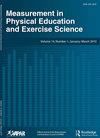Canadian Agility Movement Skill Assessment (CAMSA) in a Spanish Context: Evidences of Reliability and Validity
IF 1.9
4区 教育学
Q2 EDUCATION & EDUCATIONAL RESEARCH
Measurement in Physical Education and Exercise Science
Pub Date : 2022-01-02
DOI:10.1080/1091367X.2021.2020794
引用次数: 5
Abstract
ABSTRACT The Canadian Agility and Movement Skill Assessment (CAMSA) is a circuit-based measure of motor competence. This study aimed to investigate the validity and reliability of CAMSA in Spanish children. A sample of 749 children participated voluntarily. Acceptable-to-good internal consistency (α = .54 and G-coefficient = .88) and moderate-to-excellent inter- (ICC: .83 to 1.00), intra-rater (ICC: .99 to 1.00) and test–retest reliability (ICC: .70 to .83) was found in convenience subsamples (n = 84 observers’ reliability; n = 69 test-retest). Concurrent validity was moderate (CAMSA score with Körperkoordinationstest für Kinder: r = .45; n = 90). Confirmatory factor analysis supported the one-factor model (CFI = .95; RMSEA = .02; SRMR = .02). Boys had higher scores than girls and older-children had higher scores than younger-children. The CAMSA can be used as a valid and reliable instrument for assessing motor competence in Spanish children.西班牙背景下的加拿大敏捷动作技能评估(CAMSA):可靠性和有效性证据
摘要加拿大敏捷和运动技能评估(CAMSA)是一项基于电路的运动能力评估。本研究旨在调查西班牙儿童CAMSA的有效性和可靠性。749名儿童自愿参加。在方便的子样本中发现了可接受的良好内部一致性(α=.54,G系数=.88)和中等至优秀的inter-(ICC:.83至1.00)、内部评分者(ICC:.99至1.00)和测试-再测试可靠性(ICC:.70至.83)(n=84名观察者的可靠性;n=69名测试-重新测试)。同时有效性中等(CAMSA与Körperkordinationstest für Kinder的得分:r=.45;n=90)。验证性因素分析支持单因素模型(CFI=0.95;RMSEA=0.02;SRMR=0.02)。男孩的得分高于女孩,年龄较大的儿童的得分高于年龄较小的儿童。CAMSA可作为评估西班牙儿童运动能力的有效和可靠的工具。
本文章由计算机程序翻译,如有差异,请以英文原文为准。
求助全文
约1分钟内获得全文
求助全文
来源期刊

Measurement in Physical Education and Exercise Science
Medicine-Orthopedics and Sports Medicine
CiteScore
4.20
自引率
33.30%
发文量
24
期刊介绍:
The scope of Measurement in Physical Education and Exercise Science (MPEES) covers original measurement research, special issues, and tutorials within six substantive disciplines of physical education and exercise science. Six of the seven sections of MPEES define the substantive disciplines within the purview of the original research to be published in the journal: Exercise Science, Physical Activity, Physical Education Pedagogy, Psychology, Research Methodology and Statistics, and Sport Management and Administration. The seventh section of MPEES, Tutorial and Teacher’s Toolbox, serves to provide an outlet for review and/or didactic manuscripts to be published in the journal. Special issues provide an avenue for a coherent set of manuscripts (e.g., four to five) to collectively focus in-depth on an important and timely measurement-related issue within the scope of MPEES. The primary aim of MPEES is to publish high-impact manuscripts, most of which will focus on original research, that fit within the scope of the journal.
 求助内容:
求助内容: 应助结果提醒方式:
应助结果提醒方式:


